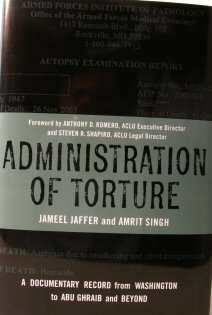Oh boy, oh boy.
As Indian Prime Minister Manmohan Singh cozies up to the Bush Administration, his youngest daughter Amrit Singh blasts the same administration for borrowing methods from tyrannical regimes (and she is right).
In her new book Administration of Torture, Manmohan Singh’s U.S-based daughter Amrit Singh plunges the dagger deep into the rotting carcass of the Bush administration, twists the knife around and exposes the maggot of lies and evasions surrounding the brutal torture of prisoners by American soldiers in Iraq, Afghanistan and Guantanamo Bay.
Written in a take-no-prisoner style, Amrit Singh and her co-author Jameel Jaffer tell a compelling and shameful story of pervasive torture, abuse and mistreatment of prisoners by the U.S. military in America’s war on terror.

Through meticulous documentation, Amrit Singh and Jameel Jaffer leave no doubt that American servicemen tortured prisoners through beating, sleep deprivation, electrocution, burning, kicking, intimidation with dogs, waterboarding and occasionally by murder.
Some American soldiers, in fact, have gone beyond torture of detainees by engaging in rape and murder of civilians as well. But American soldiers’ atrocities on civilians in Iraq and Afghanistan is a story for another day.
Administration of Torture tears into the Bush administration for merely talking the talk on commitment to democracy and human rights but not walking the walk when it comes to action.
 Amrit Singh
Amrit Singh
(Courtesy: ACLU)
A graduate of Yale Law School, Cambridge and Oxford Universities and a staff attorney with the American Civil Liberties Union, Amrit Singh (and Jameel Jaffer) argues that the well publicized abuse at Abhu Ghraib was not an aberration but widespread:
While the government continues to withhold many key records, the documents that have been released show that the abuse and torture of prisoners was not limited to Abu Ghraib but was pervasive in U.S. detention facilities in Iraq and Afghanistan and at Guantanamo Bay, and that the maltreatment of prisoners resulted in large part from decisions made by senior civilian and military officials. [P.2]
On a subsequent page, the authors write:
[T]he abuse captured in the Abu Ghraib photographs was far from isolated. The same kind of abuse, and indeed much worse, was inflicted on prisoners at detention facilities throughout Afghanistan and Iraq. [p.29]
Jameel Jaffer and Amrit Singh do not break new ground but yet go beyond daily newspaper reporting by putting the information they’ve collected from thousands of pages (via the Freedom of Information Act) into context with supporting documents and a brief easy-to-read format for those without daily access to the New York Times.
The core of the book is a short 44 pages but includes an additional 374 pages of key primary documents culled from the U.S. Army, Defense Department, FBI and other sources that strongly support the authors’ thesis of widespread torture of detainees flowing from decisions of senior military and civilian officials.
With an extensive collection of documents that include U.S. Army autopsy reports, interrogation directives, investigative files, FBI e-mail and public statements by American leaders, Amrit Singh and Jameel Jaffer tell the sad story of a fallen nation and gross mistreatment of detainees in Administration of Torture.
Contrary to the arguments of President Bush, former Defense Secretary Donald Rumsfeld and other senior U.S. officials that abuses were aberrations and the work of low-level soldiers, Amrit Singh and Jaffer respond that the government’s own documents belie the claim:
The documents establish that senior officials in Washington, including White House Counsel Alberto Gonzales, constructed a legal framework that would permit the abuse and torture of prisoners. [p.10]
In his December 2, 2002 memo, Rumsfeld clearly provided the framework for torture by authorizing special interrogation techniques like sleep deprivation, stress positions, intimidation with dogs, use of hoods on detainees during interrogation and beating (this was euphemistically called mild, non-injurious physical contact). [See Rumsfeld Memo on p.A-83]
Rumsfeld’s authorization of the above coercive techniques was characterized as torture even by some members of the military. In a memorandum to the Defense Department’s General Counsel, the U.S. Navy’s General Counsel Albert Mora wrote:
Not only could individual techniques applied singly constitute torture … but also the application of combinations of them must surely be recognized as potentially capable of reaching the level of torture. [p.13]
Following internal criticism, Rumsfeld withdrew his cruel interrogations memo on January 15, 2003 and replaced it with a less coercive interrogation manual on April 16, 2003.
But the barbaric genie had been let out of the bottle and the cruel treatment of detainees continued as the FBI agents noted. [p.17]
Despite the bullshit that Bush and Rumsfeld peddled out to the public, even the FBI conceded that the military was torturing prisoners at Guantanomo and that aggressive military interrogation methods were of “questionnable effectiveness” and not producing intelligence any different from previous FBI interrogations.
In one instance, FBI officials were particularly agitated because Department of Defense personnel were impersonating as FBI agents during interrogations:
If this detainee is ever released or his story made public in any way, DOD interrogators will not be held accountable because these torture techniques were done the “FBI” interrogators. The FBI will be left holding the bag before the public. [p. A-159]
If torture is bad in itself, its awfulness becomes amplified when innocent prisoners – who unfortunately happened to be in the wrong place at the wrong time – are tortured.
As one U.S. military commander in Abu Ghraib said in a sworn statement:
It became obvious to me that the majority of our detainees were detained as the result of being in the wrong place at the wrong time, and were swept up by Coalition Forces as peripheral bystanders during raids. I think perhaps only one in ten security detainees were of any particular intelligence value.
And guess what, some of these innocent folks detained died because of torture. [see autopsy report on p.A-187]
So, who’s got blood on their hands now?
And we’re only talking of the torture here by the U.S. military not the CIA because much of what those blundering bubblehead spooks do is still strictly sub rosa although Jameel Jaffer and Amrit Singh make a brief mention of the CIA’s use of extreme methods including murder and the agency’s Ghost Detainees. [p.34 and A-313-314]
When you keep in mind that overzealous U.S. Army personnel and CIA officials have still kept under wraps much of the information in Iraq, Afghanistan and Guantanamo Bay, you begin to wonder what other dirty, dark deeds lie hidden in those still-secret documents.
Clearly, Amrit Singh and Jameel Jaffer are unhappy that the American perpetrators of torture have not been brought to book and that many investigations of abuse have been perfunctory and punishments largely a joke. [p.40]
The documents compiled here make clear the pressing need for a serious Congressional inquiry into official responsibility for the torture and abuse of prisoners in U.S. custody. It is imperative that senior officials who authorized, endorsed or tolerated the abuse and torture of prisoners be held accountable … to ensure that the same crimes are not perpetrated again. [p.44]
Jameel Jaffer and Amrit Singh have done a fine job in producing a must-read book for those who still believe in the notion of basic human rights. They deserve our thanks.
Now that Amrit Singh (and Jameel Jaffer) has decisively exposed the use of torture by American forces in Iraq, Guantanamo Bay and Afghanistan, if only she would prevail upon her father Manmohan Singh to improve the human rights situation in Bihar, Gujarat and other dark corners of India.
After all, human rights violations by America is sporadic but a daily occurence by the state in India.
Currently a Staff Attorney at the ACLU’s Immigrants’ Rights Project, Amrit Singh is married to Barton Beebe, Associate Professor of Law at the Benjamin Cardozo School of Law of Yeshiva University on Fifth Avenue in New York City. A specialist in intellectual property law, Amrit Singh’s husband Barton Beebe works closely with the NALSAR Law University in the South Indian city of Hyderabad.
In case you feel like buying the book, it’s available at Barnes & Noble stores in the U.S. and Amazon.com.
Administration of Torture
by Jameel Jaffer and Amrit Singh
(2007: Columbia University Press, New York)
Price – $29.95

You must be logged in to post a comment Login